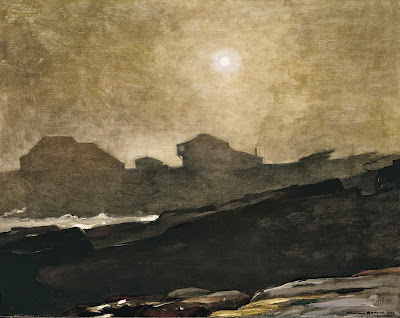Winslow Homer's Prouts Neck Studio
My first encounter with art museums was on a fourth grade school trip to the Memorial Art Gallery in Rochester, NY (my hometown). We were shuttled through the museum by an amiable docent and stopped to hear her talk about some of the work on display. I remember only one painting from that first trip, Winslow Homer's oil The Artist's Studio in an Afternoon Fog above. I didn't know much of anything about Homer (Am. 1836 - 1910) but I knew this was what I thought a painting should look like. For a nine year old, I think I had pretty good taste.
Here's a photo of the same studio I took last Friday afternoon. My wife Alice and I were headed up to Acadia National Park in Maine to go painting. We took time to visit the recently re-opened studio of Winslow Homer in Prouts Neck, just south of Portland. The Portland Museum of Art purchased and completely overhauled and restored the property to match as closely as possible how it appeared when Homer was painting in it. Anyone who loves Homer would love touring this restored studio.
The studio is all about the ocean, Homer's signature subject. For a studio Homer had his family's carriage house dragged close to the water so he could study the light on the waves and get lost in their watery magic. He had an architect design a cantilevered second floor balcony which Homer colorfully referred to as his "piazza" so he could get a panoramic view of the sea. Here is Alice checking out what Homer so loved to gaze upon.
I have a particular curiosity about the Homer studio as he was one of the artists who had done the most to shape American realist painting when Edward Hopper (Am. 1882 - 1967) began finding his own footing as an artist. And I feel there is much of Homer in Edward Hopper's way of seeing- forms pared down to essential volumes, a remarkable awareness of the drama of light, and a deep love of the natural world.
Hopper, perhaps unconsciously imitating Homer, built a studio on the shore of Cape Cod Bay in Truro, MA, just off the open water of the Atlantic. Here I am just about this time last fall during my 14th residency at Hopper's studio. As you can imagine, it's a place that compels you to look out to sea.
Homer's studio differs from Hopper's in one striking way- Hopper had much more natural light to work under than Homer. Hopper had designed his Truro studio to include a 10' tall north facing window that literally floods the room with cool unchanging light. Homer's studio had fewer and smaller windows. Not surprisingly, Homer generally painted darker paintings than Hopper, though part of that was Homer's coming of age in the mid 19th century.
Here's the inside of Homer's painting room with part of the tour group we came with from the Portland Museum of Art.
Another view of the painting room:
In the painting room the Portland Museum of Art has installed text panels telling about Homer and his art. The panel in the photo below feature some of the paintings Homer made of the area around the studio, including Memorial Art Gallery's oil of Homer's studio I had loved so much as a boy.
Here's a detail:
The studio seen from the shore:
I have more Homer studio photos. Shortly I will put some in a follow up post on this blog.













